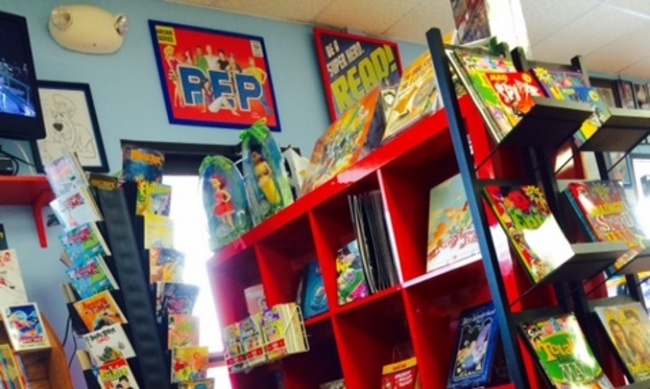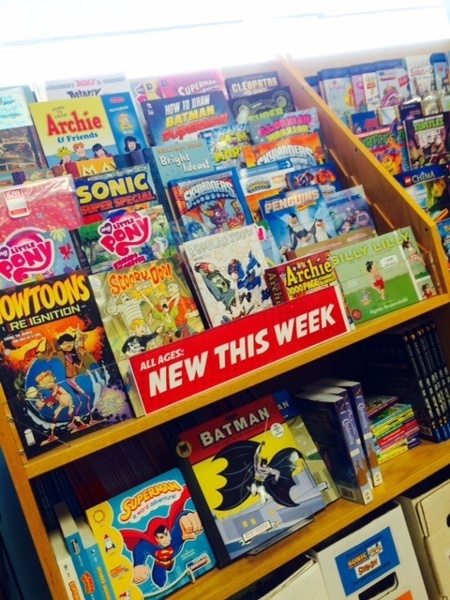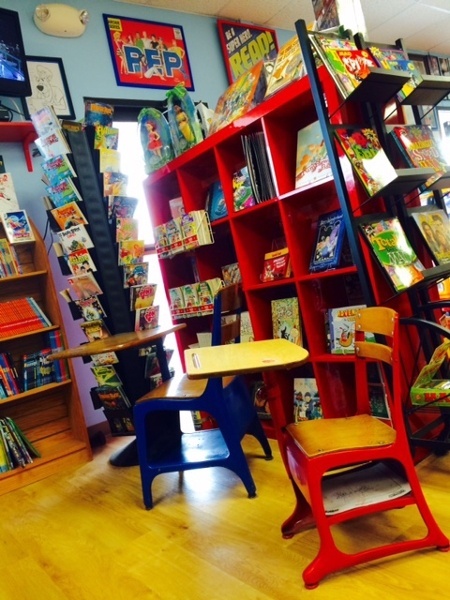As part of ICv2’s "Grow the Business with Kids" event, we spoke with Joe Murray, the owner of Captain Blue Hen Comics in Newark, Delaware, on how his store has successfully marketed to children and families. In Part 2, we talk about the ancillary benefits of the kids area, events, and the philosophy of the store layout. In Part 1, we talked about his display area, how the section compares financially to other parts of the store, and building a relationship with libraries.
Do you have a location that is mostly foot traffic, or do you get destination shoppers?
We’re a destination shop.
So parents with kids are coming to you to find things for their child.
Exactly, yes.
What percentage of your space do you devote to the all ages or family section?
I would say it’s 10 to 15%.
And generating that much or more of your revenues?
It’s hard to say. 60% comes from your regulars and their comics, the weekly periodicals. Out of the remainder of that, it might generate 5-10%.
I believe it is money well spent. Even if it doesn’t necessarily generate the 1:1 ratio for floor space to revenue, what it generates is good will and an opportunity for the parents to shop the store for other stuff as well.
It’s like a kid at a tire store. You’re getting your tires changed and the kid does not want to be there, and it just becomes a pain for the parents to be dragging their kid there. Anybody who comes in here and they’ve got kids, we’ve got something to keep them entertained. We have little desks and coloring pages, so for the very littlest kids there’s something for them to do so they’re not going to be dragging their parent away from shopping.
We know that little siblings always want to do what their older siblings are doing. They might not be old enough to read a comic book yet, but we carry lots of the little 8" by 8" books from bookstores that feature the same characters, that feature the DC superheroes or the members of the Avengers, or My Little Pony, suitable for three-year-olds to eight-year-olds. So they can leave with a book appropriate for them for the same amount of money as an older sibling who’s paying for a $3.99 comic book. They’re a great little add-on sale.
A lot of our family readers are parents who came in and collected comics and now they’re introducing it to the next generation. For that reason alone, it’s important to keep them as feeder readers for the future.
You do have the ones who heard about something on NPR and come in. Our family section also includes Asterix and Tintin. Also since we’re near a university, we get ESL [English as a Second Language—ed.] students who come into that section looking for Calvin and Hobbes and Tintin and Asterix.
And since My Little Pony books came in, you’re also feeding bronies. Zelda’s over there which appeals to another age group. There’s usually some humor books in there. Archie sells well to both kids and to adults so it’s not a straight black and white kids’ thing. One of the books that we sold a tremendous amount of is a Franklin Richards book, and we sell that to all kinds of ages.
Do you do any events for kids?
Yes. Our Free Comic Book Day is aimed primarily at kids. In December we do usually a number of events. We had a Grootness event, from Groot from Guardians of the Galaxy, where we had kids’ activities like make your own Baby Groot, a Baby Groot dance-off. This week for Children’s Book Week, we’re going to have Steve Conley for his book Luke, the Space Monkey.
We had Nathan Hale here—Nathan Hale’s Hazardous Tales. That was something where we worked in conjunction with the school district. They have an event called Real Men Read that we always head up and have helped them out for a number of years. We help them find a guest to bring in for that event. They brought in Nathan Hale, who flew in from Utah. The event was Thursday night but he was also supposed to be presenting at the schools on Friday but we had a really bad cold streak so all the schools were closed and a bunch of kids were not going to be able to see him.
We made a deal and hosted him for that Friday at our store. The school district sent out word that if you want to get to see him, this is where he’ll be that day. Again, that’s an event that didn’t cost us anything. We were doing them a favor, they were doing us a favor, and now everyone in that school district knows that Captain Blue Hen exists.
Does the Nathan Hale series do well for you?
It’s not a tremendous great seller. We’ve had a bump since we had him, but it’s solid and consistent. It turns over more than certain DC trades.
Anything else you want to share about marketing to families?
The way our store is laid out is more like a book store with comic book overtones.
The idea is when you first walk in, 80% of our marketing is to 20% of the people because the regulars, your bread and butter, while we give them all the attention they merit and deserve, are kind of low maintenance. They’re going to go straight back to the new releases, they’re going to pick up their books, they know where they’re at and what they’re looking for already.
Our store is set up so when you first walk in, if you’re a muggle (that’s the term we use if you’ve never been in a comic shop or anything) you’re going to feel comfortable because the first things you’re going to be greeted with are familiar faces, characters, stuff that you would have seen elsewhere and that it kind of looks like a book store initially. As you come in, the rest of the world opens up to you gradually so that you’re not overwhelmed, that way it’s family friendly. Like Joe Field said, we don’t have inappropriate sexed up posters on the walls or anything like that (see "ICv2 Interview: Flying Colors' Joe Field").
The front part of the store is for people who are not necessarily comic fans or well versed in it, and then as you come in, as you’re drawn in, you get deeper and deeper into the world. So you kind of feel comfortable, you’re not overwhelmed by it when you first come in. And then the kids section is over in another corner so it’s not right by the door. The kids aren’t going to be able to run out, or the parents aren’t going to be able to lose track of them—they can see them from anywhere in the store.
Click here to go back to Part 1.

Why Have a Kids Area, Events, the Philosophy of the Store
Posted by ICv2 on May 8, 2015 @ 2:35 am CT




